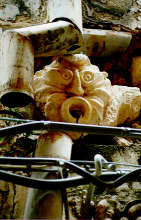1) In situ experimentation has allowed, after one year of exposure, a first visual evaluation on the behaviour, in the time, of different categories of products.
In the plasters are underlined qualitative differences between the traditional systems and those contemporary; for instance, the common lime plasters have suffered a deterioration few weeks after their application. We have had the opportunity to notice that, generally, the industrial plasters are made with predominantly fine gradation sands (proper, generally, for the realization of the layer of finish). The effects of this custom (in clean contrast with the millennial constructive tradition) can be evaluated only with spending of time on the occasion of further investigations.
During the tests, some manufacturers, remarking inadequate adaptation of their products to the specificities of the local reality, have asked of to be able to repeat the application modifying it in relation to the peculiarities of the site.
After a couple of years of exposure, the features of the exposed plasters (adhesion to the support, absence of pulverization, resistance to the atmospheric agents, retention of dust, etc.) have furnished extremely useful indications on the performances of the sampled systems; nevertheless, for a definitive judgment it is necessary to let spend other time.
2) From the analyses of laboratory the following indications occur :
The stones are exclusively constituted by limestone deriving from quarries located in the proximity of the city (1) .
Non decorative stones, protected, according to the local tradition by lime coatings, are preserved, while those exposed to the atmospheric agents have been suffering different kinds of deterioration.
The analysed plasters (of more or less recent construction) show damages for the action of the soluble salts; the absence of stratifications induces the consideration that in Ortygia the strong deterioration of plasters has pushed the inhabitants to continuous remaking.
The influence of the deterioration induced by the atmospheric pollutants results, generally, few remarkable. Nevertheless, on the roads with presence of intense traffic, we have found, limitedly to the protected zones from the washing away of the waters, black crusts constituted in gypsum prevalence (calcium sulphate bi-hydrate) due to the interaction between the carbonate component of the stone and the atmospheric sulphurous anhydride. The gypsum crystals, arranged in the typical conformation of "rose of the desert", have a varying thickness from the millimetre up to the centimetre and are characterized by numerous discontinuities that allow the entry of the rain. Apart from the thickness of the crust, the surface of stones is strongly pulverized.
Ordinary presence of soluble salts (both in surface and in depth) characterizes the most of buildings. The salts' crystallization, above all under form of crypto-efflorescence, represents, for plasters, the principal cause of the erosion, of the pulverization and of the separation from the building structure and for the stones it causes the phenomenon of the alveolar erosion.
The presence of the gypsum crusts and the diffusion of the soluble salts dissuades the use of techniques of cleaning with water systems.
The ordinary presence of soluble salts imposes, before proceeding to the repair of the stones or to the placing of new plasters, the execution of interventions directed to their extraction or interception.
The study of some building typologies has underlined, besides, presence of recurrent constructive defects due to the absence or to the inadequacy of the systems of canalisation and of defence from meteoric waters. It is also underlined the absence of any form of protection against the superficial slide of the waters.
|
3) Editing of the Code of professional practice (2) .
In the light of data emerged by the scientific investigations, the Code of professional practice proposes a series of technical solutions organizing them, in relations to the aims of every single intervention, in the following way:
Description of criteria to follow, in the choice of workmanships, accordingly to the actual addresses of method of the architectural conservation (maintenance of the informative content, least intervention, etc);
- Description of the aims of the work;
- Description of the technique in examination;
- Description of the materials thought fitter in relation to the specific application;
- Detailed description of the formalities of getting under way;
- Instructions on the risks and on the possible contraindications;
- Summarizing files for a critical reflection on the effects of the workmanships in relation to the maintenance of the informative content of the work, to the reversibility, to the compatibility, to the possibility of maintenance, to the duration and cost.
- This type of formulation, directs the planner to the critical analysis of the single technical solutions and allows professionals to perform, time for time, the fittest choice in absence of dangerous pre-defined and ready-to-use solutions.
(1) The necessity to reconstruct in hurry the buildings (earthquake on the1693) has caused the abandonment of the historical quarries (distant) in favour of nearest but decidedly more cheap ones.
(2) For limits of space a schematic description is reported. The "code of professional practice " is in press, for further details on the matter you see : Sergio Tinè "Codice di pratica professionale per il restauro delle fronti esterne degli edifici di Ortygia - Alcuni contributi preliminari" in Gli speciali di Recupero & Conservazione, De Lettera Editore , Milano 1999; |


